Communication over the network
The Elements of Communication
Communication begins with a message, or information, that must be sent from one individual or device to another. People exchange ideas using many different communication methods. All of these methods have three elements in common. The first of these elements is the message source, or sender. Message sources are people, or electronic devices, that need to send a message to other individuals or devices. The second element of communication is the destination, or receiver, of the message. The destination receives the message and interprets it. A third element, called a channel, consists of the media that provides the pathway over which the message can travel from source to destination. Consider, for example, the desire to communicate using words, pictures, and sounds. Each of these messages can be sent across a data or information network by first converting them into binary digits, or bits. These bits are then encoded into a signal that can be transmitted over the appropriate medium. In computer networks, the media is usually a type of cable, or a wireless transmission. The term network in this course will refer to data or information networks capable of carrying many different types of communications, including traditional computer data, interactive voice, video, and entertainment products.
Communicating the Messages
In theory, a single communication, such as a music video or an e-mail message, could be sent across a network from a source to a destination as one massive continuous stream of bits. If messages were actually transmitted in this manner, it would mean that no other device would be able to send or receive messages on the same network while this data transfer was in progress. These large streams of data would result in significant delays. Further, if a link in the interconnected network infrastructure failed during the transmission, the complete message would be lost and have to be retransmitted in full. A better approach is to divide the data into smaller, more manageable pieces to send over the network. This division of the data stream into smaller pieces is called segmentation. Segmenting messages has two primary benefits. First, by sending smaller individual pieces from source to destination, many different conversations can be interleaved on the network. The process used to interleave the pieces of separate conversations together on the network is called multiplexing. Second, segmentation can increase the reliability of network communications. The separate pieces of each message need not travel the same pathway across the network from source to destination. If a particular path becomes congested with data traffic or fails, individual pieces of the message can still be directed to the destination using alternate pathways. If part of the message fails to make it to the destination, only the missing parts need to be retransmitted.
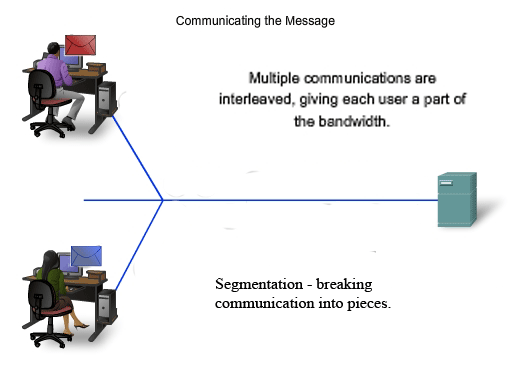
The downside to using segmentation and multiplexing to transmit messages across a network is the level of complexity that is added to the process. Imagine if you had to send a 100-page letter, but each envelope would only hold one page. The process of addressing, labeling, sending, receiving, and opening the entire hundred envelopes would be time-consuming for both the sender and the recipient.
In network communications, each segment of the message must go through a similar process to ensure that it gets to the correct destination and can be reassembled into the content of the original message. Various types of devices throughout the network participate in ensuring that the pieces of the message arrive reliably at their destination.
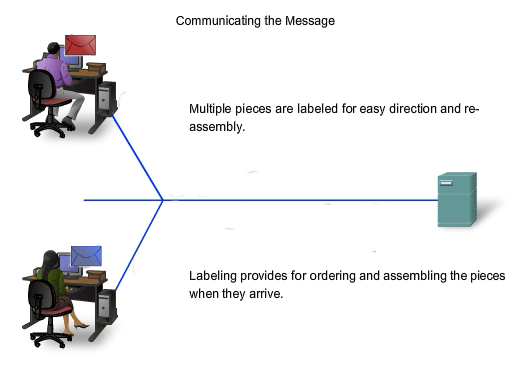
Components of the Network
The path that a message takes from source to destination can be as simple as a single cable connecting one computer to another or as complex as a network that literally spans the globe. This network infrastructure is the platform that supports our human network. It provides the stable and reliable channel over which our communications can occur. Devices and media are the physical elements or hardware of the network. Hardware is often the visible components of the network platform such as a laptop, a PC, a switch, or the cabling used to connect the devices. Occasionally, some components may not be so visible. In the case of wireless media, messages are transmitted through the air using invisible radio frequency or infrared waves. Services and processes are the communication programs, called software, that run on the networked devices. A network service provides information in response to a request. Services include many of the common network applications people use every day, like e-mail hosting services and web hosting services. Processes provide the functionality that directs and moves the messages through the network. Processes are less obvious to us but are critical to the operation of networks.

End Devices and their Role on the Network
The network devices that people are most familiar with are called end devices. These devices form the interface between the human network and the underlying communication network. Some examples of end devices are:
-
Computers (work stations, laptops, file servers, web servers)
- Network printers
- VoIP phones
- Security cameras
- Mobile handheld devices (such as wireless barcode scanners, PDAs)
In the context of a network, end devices are referred to as hosts. A host device is either the source or destination of a message transmitted over the network. In order to distinguish one host from another, each host on a network is identified by an address. When a host initiates communication, it uses the address of the destination host to specify where the message should be sent. In modern networks, a host can act as a client, a server, or both. Software installed on the host determines which role it plays on the network. Servers are hosts that have software installed that enables them to provide information and services, like e-mail or web pages, to other hosts on the network. Clients are hosts that have software installed that enables them to request and display the information obtained from the server.
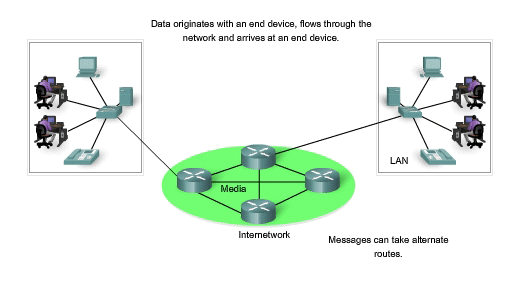
Intermediary Devices and their Role on the Network
In addition to the end devices that people are familiar with, networks rely on intermediary devices to provide connectivity and to work behind the scenes to ensure that data flows across the network. These devices connect the individual hosts to the network and can connect multiple individual networks to form an internetwork. Examples of intermediary network devices are:
-
Network Access Devices (Hubs, switches, and wireless access points)
- Internetworking Devices (routers)
- Communication Servers and Modems
- Security Devices (firewalls)
The management of data as it flows through the network is also a role of the intermediary devices. These devices use the destination host address, in conjunction with information about the network interconnections, to determine the path that messages should take through the network. Processes running on the intermediary network devices perform these functions:
-
Regenerate and retransmit data signals
- Maintain information about what pathways exist through the network and internetwork
- Notify other devices of errors and communication failures
- Direct data along alternate pathways when there is a link failure
- Classify and direct messages according to QoS priorities
- Permit or deny the flow of data, based on security settings
Network Media
Communication across a network is carried on a medium. The medium provides the channel over which the message travels from source to destination. Modern networks primarily use three types of media to interconnect devices and to provide the pathway over which data can be transmitted. These media are:
-
Metallic wires within cables
- Glass or plastic fibers (fiber optic cable)
- Wireless transmission
The signal encoding that must occur for the message to be transmitted is different for each media type. On metallic wires, the data is encoded into electrical impulses that match specific patterns. Fiber optic transmissions rely on pulses of light, within either infrared or visible light ranges. In wireless transmission, patterns of electromagnetic waves depict the various bit values. Different types of network media have different features and benefits. Not all network media has the same characteristics and is appropriate for the same purpose. Criteria for choosing a network media are:
-
The distance the media can successfully carry a signal.
- The environment in which the media is to be installed.
- The amount of data and the speed at which it must be transmitted.
- The cost of the media and installation
LANs, WANs, and Internetworks
Local Area Networks
Networks infrastructures can vary greatly in terms of:
-
The size of the area covered
- The number of users connected
- The number and types of services available
An individual network usually spans a single geographical area, providing services and applications to people within a common organizational structure, such as a single business, campus or region. This type of network is called a Local Area Network. A LAN is usually administered by a single organization. The administrative control that governs the security and access control policies are enforced on the network level.
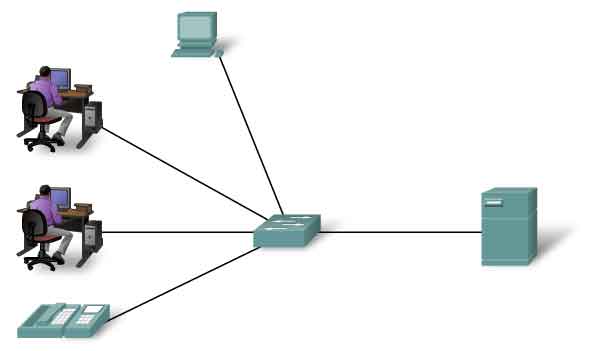
Wide Area Networks
When a company or organization has locations that are separated by large geographical distances, it may be necessary to use a telecommunications service provider (TSP) to interconnect the LANs at the different locations. Telecommunications service providers operate large regional networks that can span long distances. Traditionally, TSPs transported voice and data communications on separate networks. Increasingly, these providers are offering converged information network services to their subscribers. Individual organizations usually lease connections through a telecommunications service provider network. These networks that connect LANs in geographically separated locations are referred to as Wide Area Networks (WANs). Although the organization maintains all of the policies and administration of the LANs at both ends of the connection, the policies within the communications service provider network are controlled by the TSP.
WANs use specifically designed network devices to make the interconnections between LANs. Because of the importance of these devices to the network, configuring, installing and maintaining these devices are skills that are integral to the function of an organization's network. LANs and WANs are very useful to individual organizations. They connect the users within the organization. They allow many forms of communication including exchange e-mails, corporate training, and other resource sharing.
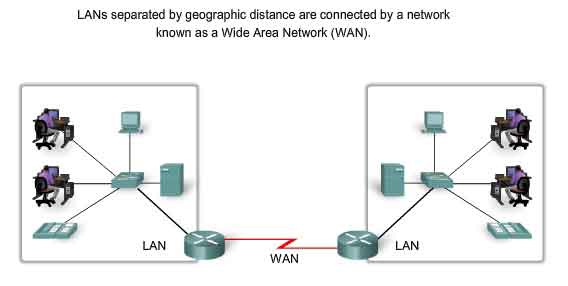
The Internet - A Network of Networks
Although there are benefits to using a LAN or WAN, most of us need to communicate with a resource on another network, outside of our local organization.
Examples of this type of communication include:
-
Sending an e-mail to a friend in another country
- Accessing news or products on a website
- Getting a file from a neighbor's computer
- Instant messaging with a relative in another city
- Following a favorite sporting team's performance on a cell phone
Internetwork
A global mesh of interconnected networks (internetworks) meets these human communication needs. Some of these interconnected networks are owned by large public and private organizations, such as government agencies or industrial enterprises, and are reserved for their exclusive use. The most well-known and widely used publicly-accessible internetwork is the Internet. The Internet is created by the interconnection of networks belonging to Internet Service Providers (ISPs). These ISP networks connect to each other to provide access for millions of users all over the world. Ensuring effective communication across this diverse infrastructure requires the application of consistent and commonly recognized technologies and protocols as well as the cooperation of many network administration agencies.
Intranet
The term intranet is often used to refer to a private connection of LANs and WANs that belongs to an organization, and is designed to be accessible only by the organization's members, employees, or others with authorization. Note: The following terms may be interchangeable: internetwork, data network, and network. A connection of two or more data networks forms an internetwork - a network of networks. It is also common to refer to an internetwork as a data network - or simply as a network - when considering communications at a high level. The usage of terms depends on the context at the time and terms may often be interchanged.

Protocols
Rules that Govern Communications
All communication, whether face-to-face or over a network, is governed by predetermined rules called protocols. These protocols are specific to the characteristics of the conversation. In our day-to-day personal communication, the rules we use to communicate over one medium, like a telephone call, are not necessarily the same as the protocols for using another medium, such as sending a letter. Think of how many different rules or protocols govern all the different methods of communication that exist in the world today. Successful communication between hosts on a network requires the interaction of many different protocols. A group of inter-related protocols that are necessary to perform a communication function is called a protocol suite. These protocols are implemented in software and hardware that is loaded on each host and network device. One of the best ways to visualize how all of the protocols interact on a particular host is to view it as a stack. A protocol stack shows how the individual protocols within the suite are implemented on the host. The protocols are viewed as a layered hierarchy, with each higher level service depending on the functionality defined by the protocols shown in the lower levels. The lower layers of the stack are concerned with moving data over the network and providing services to the upper layers, which are focused on the content of the message being sent and the user interface.
Using layers to describe face-to-face communication
For example, consider two people communicating face-to-face. As the figure shows, we can use three layers to describe this activity. At the bottom layer, the physical layer, we have two people, each with a voice that can utter words aloud. At the second layer, the rules layer, we have an agreement to speak in a common language. At the top layer, the content layer, we have the words actually spoken-the content of the communication.Were we to witness this conversation, we would not actually see "layers" floating in space. It is important to understand that the use of layers is a model and, as such, it provides a way to conveniently break a complex task into parts and describe how they work.
Network Protocols
At the human level, some communication rules are formal and others are simply understood, or implicit, based on custom and practice. For devices to successfully communicate, a network protocol suite must describe precise requirements and interactions.
Networking protocol suites describe processes such as:
-
The format or structure of the message
- The method by which networking devices share information about pathways with other networks
- How and when error and system messages are passed between devices
- The setup and termination of data transfer sessions
Individual protocols in a protocol suite may be vendor-specific and proprietary. Proprietary, in this context, means that one company or vendor controls the definition of the protocol and how it functions. Some proprietary protocols can be used by different organizations with permission from the owner. Others can only be implemented on equipment manufactured by the proprietary vendor.
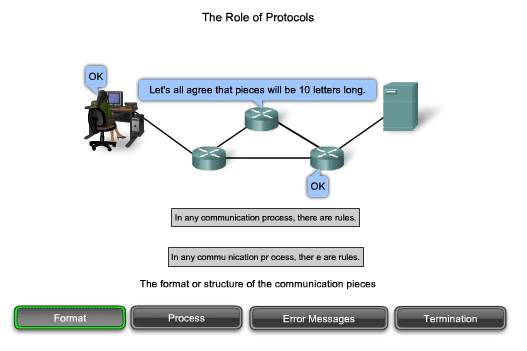
Protocol Suites and Industry Standards
Often, many of the protocols that comprise a protocol suite reference other widely utilized protocols or industry standards. A standard is a process or protocol that has been endorsed by the networking industry and ratified by a standards organization, such as the Institute of Electrical and Electronics Engineers (IEEE) or the Internet Engineering Task Force (IETF). The use of standards in developing and implementing protocols ensures that products from different manufacturers can work together for efficient communications. If a protocol is not rigidly observed by a particular manufacturer, their equipment or software may not be able to successfully communicate with products made by other manufacturers. In data communications, for example, if one end of a conversation is using a protocol to govern one-way communication and the other end is assuming a protocol describing two-way communication, in all probability, no information will be exchanged
The Interaction of Protocols
An example of the use of a protocol suite in network communications is the interaction between a web server and a web browser. This interaction uses a number of protocols and standards in the process of exchanging information between them. The different protocols work together to ensure that the messages are received and understood by both parties. Examples of these protocols are:
Application Protocol:
Hypertext Transfer Protocol (HTTP) is a common protocol that governs the way that a web server and a web client interact. HTTP defines the content and formatting of the requests and responses exchanged between the client and server. Both the client and the web server software implement HTTP as part of the application. The HTTP protocol relies on other protocols to govern how the messages are transported between client and server
Transport Protocol:
Transmission Control Protocol (TCP) is the transport protocol that manages the individual conversations between web servers and web clients. TCP divides the HTTP messages into smaller pieces, called segments, to be sent to the destination client. It is also responsible for controlling the size and rate at which messages are exchanged between the server and the client.
Internetwork Protocol:
The most common internetwork protocol is Internet Protocol (IP). IP is responsible for taking the formatted segments from TCP, encapsulating them into packets, assigning the appropriate addresses, and selecting the best path to the destination host.
Network Access Protocols:
Network access protocols describe two primary functions, data link management and the physical transmission of data on the media. Data-link management protocols take the packets from IP and format them to be transmitted over the media. The standards and protocols for the physical media govern how the signals are sent over the media and how they are interpreted by the receiving clients. Transceivers on the network interface cards implement the appropriate standards for the media that is being used.
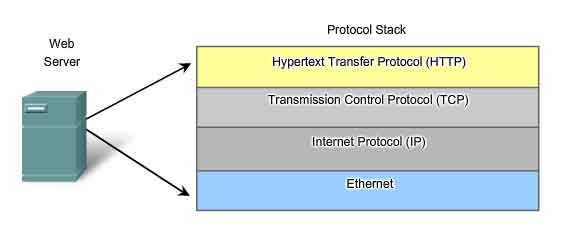
Technology Independent Protocols
Networking protocols describe the functions that occur during network communications. In the face-to-face conversation example, a protocol for communicating might state that in order to signal that the conversation is complete, the sender must remain silent for two full seconds. However, this protocol does not specify how the sender is to remain silent for the two seconds. Protocols generally do not describe how to accomplish a particular function. By describing only what functions are required of a particular communication rule but not how they are to be carried out, the implementation of a particular protocol can be technology-independent. Looking at the web server example, HTTP does not specify what programming language is used to create the browser, which web server software should be used to serve the web pages, what operating system the software runs on, or the hardware requirements necessary to display the browser. It also does not describe how the server should detect errors, although it does describe what the server should do if an error occurs. This means that a computer - and other devices, like mobile phones or PDAs - can access a web page stored on any type of web server that uses any form of operating system from anywhere on the Internet.
Using Layered Models
The Benefits of Using a Layered Model
To visualize the interaction between various protocols, it is common to use a layered model. A layered model depicts the operation of the protocols occurring within each layer, as well as the interaction with the layers above and below it.
There are benefits to using a layered model to describe network protocols and operations. Using a layered model:
-
Assists in protocol design, because protocols that operate at a specific layer have defined information that they act upon and a defined interface to the layers above and below.
- Fosters competition because products from different vendors can work together.
- Prevents technology or capability changes in one layer from affecting other layers above and below.
- Provides a common language to describe networking functions and capabilities.
Protocol and Reference Models
There are two basic types of networking models: protocol models and reference models. A protocol model provides a model that closely matches the structure of a particular protocol suite. The hierarchical set of related protocols in a suite typically represents all the functionality required to interface the human network with the data network. The TCP/IP model is a protocol model because it describes the functions that occur at each layer of protocols within the TCP/IP suite. A reference model provides a common reference for maintaining consistency within all types of network protocols and services. A reference model is not intended to be an implementation specification or to provide a sufficient level of detail to define precisely the services of the network architecture. The primary purpose of a reference model is to aid in clearer understanding of the functions and process involved. The Open Systems Interconnection (OSI) model is the most widely known internetwork reference model. It is used for data network design, operation specifications, and troubleshooting. Although the TCP/IP and OSI models are the primary models used when discussing network functionality, designers of network protocols, services, or devices can create their own models to represent their products. Ultimately, designers are required to communicate to the industry by relating their product or service to either the OSI model or the TCP/IP model, or to both.

The TCP/IP Model
The first layered protocol model for internetwork communications was created in the early 1970s and is referred to as the Internet model. It defines four categories of functions that must occur for communications to be successful. The architecture of the TCP/IP protocol suite follows the structure of this model. Because of this, the Internet model is commonly referred to as the TCP/IP model. Most protocol models describe a vendor-specific protocol stack. However, since the TCP/IP model is an open standard, one company does not control the definition of the model. The definitions of the standard and the TCP/IP protocols are discussed in a public forum and defined in a publicly-available set of documents. These documents are called Requests for Comments (RFCs). They contain both the formal specification of data communications protocols and resources that describe the use of the protocols. The RFCs also contain technical and organizational documents about the Internet, including the technical specifications and policy documents produced by the Internet Engineering Task Force (IETF).
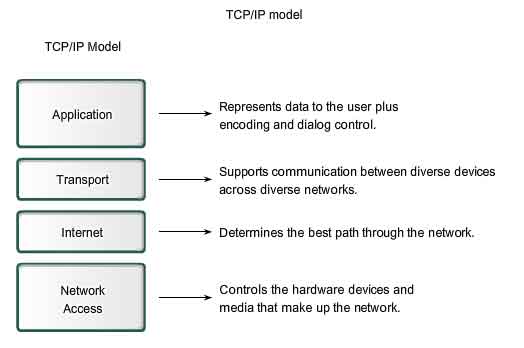
The Communication Process
The TCP/IP model describes the functionality of the protocols that make up the TCP/IP protocol suite. These protocols, which are implemented on both the sending and receiving hosts, interact to provide end-to-end delivery of applications over a network.
A complete communication process includes these steps:
1. Creation of data at the application layer of the originating source end device
2. Segmentation and encapsulation of data as it passes down the protocol stack in the source end device
3. Generation of the data onto the media at the network access layer of the stack
4. Transportation of the data through the internetwork, which consists of media and any intermediary devices
5. Reception of the data at the network access layer of the destination end device
6. Decapsulation and reassembly of the data as it passes up the stack in the destination device
7. Passing this data to the destination application at the Application layer of the destination end device
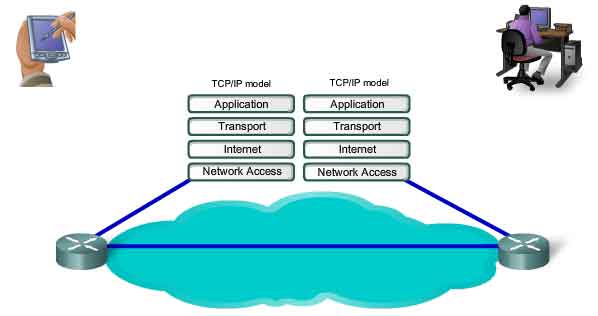
Protocol Data Units and Encapsulation
As application data is passed down the protocol stack on its way to be transmitted across the network media, various protocols add information to it at each level. This is commonly known as the encapsulation process. The form that a piece of data takes at any layer is called a Protocol Data Unit (PDU). During encapsulation, each succeeding layer encapsulates the PDU that it receives from the layer above in accordance with the protocol being used. At each stage of the process, a PDU has a different name to reflect its new appearance. Although there is no universal naming convention for PDUs, in this course, the PDUs are named according to the protocols of the TCP/IP suite.
-
Data - The general term for the PDU used at the Application layer
- Segment - Transport Layer PDU
- Packet - Internetwork Layer PDU
- Frame - Network Access Layer PDU
- Bits - A PDU used when physically transmitting data over the medium
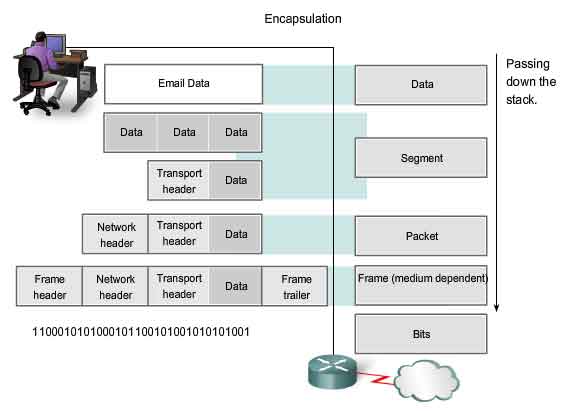
The Sending and Receiving Process
When sending messages on a network, the protocol stack on a host operates from top to bottom. In the web server example, we can use the TCP/IP model to illustrate the process of sending an HTML web page to a client. The Application layer protocol, HTTP, begins the process by delivering the HTML formatted web page data to the Transport layer. There the application data is broken into TCP segments. Each TCP segment is given a label, called a header, containing information about which process running on the destination computer should receive the message. It also contains the information to enable the destination process to reassemble the data back to its original format. The Transport layer encapsulates the web page HTML data within the segment and sends it to the Internet layer, where the IP protocol is implemented. Here the entire TCP segment is encapsulated within an IP packet, which adds another label, called the IP header. The IP header contains source and destination host IP addresses, as well as information necessary to deliver the packet to its corresponding destination process. Next, the IP packet is sent to the Network Access layer Ethernet protocol where it is encapsulated within a frame header and trailer. Each frame header contains a source and destination physical address. The physical address uniquely identifies the devices on the local network. The trailer contains error checking information. Finally the bits are encoded onto the Ethernet media by the server NIC.
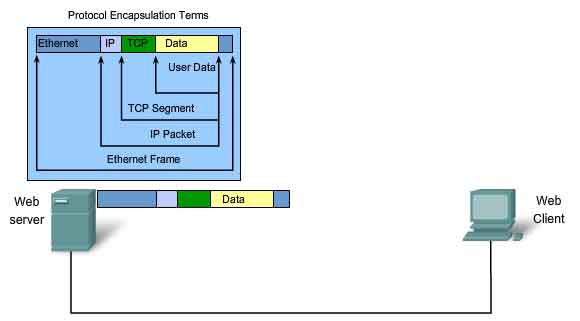
The OSI Model
Initially the OSI model was designed by the International Organization for Standardization (ISO) to provide a framework on which to build a suite of open systems protocols. The vision was that this set of protocols would be used to develop an international network that would not be dependent on proprietary systems. Unfortunately, the speed at which the TCP/IP based Internet was adopted, and the rate at which it expanded, caused the OSI Protocol Suite development and acceptance to lag behind. Although few of the protocols developed using the OSI specifications are in widespread use today, the seven-layer OSI model has made major contributions to the development of other protocols and products for all types of new networks. As a reference model, the OSI model provides an extensive list of functions and services that can occur at each layer. It also describes the interaction of each layer with the layers directly above and below it. Although the content of this course will be structured around the OSI Model the focus of discussion will be the protocols identified in the TCP/IP protocol stack. Note that whereas the TCP/IP model layers are referred to only by name, the seven OSI model layers are more often referred to by number than by name.
-
Application layer provides the means for end-to-end connectivity between individuals in the human network using data networks.
- Presentation layer provides for common representation of data transferred between Application layer services.
- Session layer provides services to the Presentation layer to organize its dialogue and to manage data exchange.
- Transport layer defines services to segment, transfer, and reassemble the data for individual communications between the end devices.
- Network layer provides services to exchange the individual pieces of data over the network between identified end devices.
- The Data Link layer protocols describe methods for exchanging data frames between devices over a common media.
- The Physical layer protocols describe the mechanical, electrical, functional, and procedural means to activate, maintain, and de-activate physical-connections for bit transmission to and from a network device.
Comparing the OSI Model with the TCP/IP Model
The protocols that make up the TCP/IP protocol suite can be described in terms of the OSI reference model. In the OSI model, the Network Access layer and the Application layer of the TCP/IP model are further divided to describe discreet functions that need to occur at these layers. At the Network Access Layer, the TCP/IP protocol suite does not specify which protocols to use when transmitting over a physical medium; it only describes the handoff from the Internet Layer to the physical network protocols. The OSI Layers 1 and 2 discuss the necessary procedures to access the media and the physical means to send data over a network. The key parallels between the two network models occur at the OSI model Layers 3 and 4. OSI Model Layer 3, the Network layer, almost universally is used to discuss and document the range of processes that occur in all data networks to address and route messages through an internetwork. The Internet Protocol (IP) is the TCP/IP suite protocol that includes the functionality described at Layer 3. Layer 4, the Transport layer of the OSI model, is often used to describe general services or functions that manage individual conversations between source and destination hosts. These functions include acknowledgement, error recovery, and sequencing. At this layer, the TCP/IP protocols Transmission Control Protocol (TCP) and User Datagram Protocol (UDP) provide the necessary functionality. The TCP/IP Application layer includes a number of protocols that provide specific functionality to a variety of end user applications. The OSI model Layers 5, 6 and 7 are used as references for application software developers and vendors to produce products that need to access networks for communications.
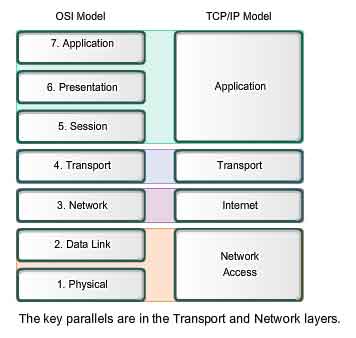
Network Addressing
Addressing in the Network
The OSI model describes the processes of encoding, formatting, segmenting, and encapsulating data for transmission over the network. A data stream that is sent from a source to a destination can be divided into pieces and interleaved with messages traveling from other hosts to other destinations. Billions of these pieces of information are traveling over a network at any given time. It is critical for each piece of data to contain enough identifying information to get it to the correct destination. There are various types of addresses that must be included to successfully deliver the data from a source application running on one host to the correct destination application running on another. Using the OSI model as a guide, we can see the different addresses and identifiers that are necessary at each layer.

Getting the Data to the End Device
During the process of encapsulation, address identifiers are added to the data as it travels down the protocol stack on the source host. Just as there are multiple layers of protocols that prepare the data for transmission to its destination, there are multiple layers of addressing to ensure its delivery. The first identifier, the host physical address, is contained in the header of the Layer 2 PDU, called a frame. Layer 2 is concerned with the delivery of messages on a single local network. The Layer 2 address is unique on the local network and represents the address of the end device on the physical media. In a LAN using Ethernet, this address is called the Media Access Control (MAC) address. When two end devices communicate on the local Ethernet network, the frames that are exchanged between them contain the destination and source MAC addresses. Once a frame is successfully received by the destination host, the Layer 2 address information is removed as the data is decapsulated and moved up the protocol stack to Layer 3.
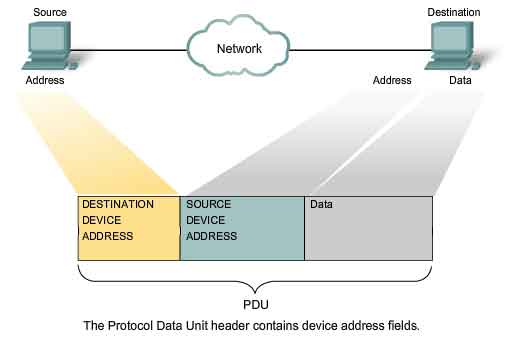
Getting the Data through the Internetwork
Layer 3 protocols are primarily designed to move data from one local network to another local network within an internetwork. Whereas Layer 2 addresses are only used to communicate between devices on a single local network, Layer 3 addresses must include identifiers that enable intermediary network devices to locate hosts on different networks. In the TCP/IP protocol suite, every IP host address contains information about the network where the host is located. At the boundary of each local network, an intermediary network device, usually a router, decapsulates the frame to read the destination host address contained in the header of the packet, the Layer 3 PDU. Routers use the network identifier portion of this address to determine which path to use to reach the destination host. Once the path is determined, the router encapsulates the packet in a new frame and sends it on its way toward the destination end device. When the frame reaches its final destination, the frame and packet headers are removed and the data moved up to Layer 4.
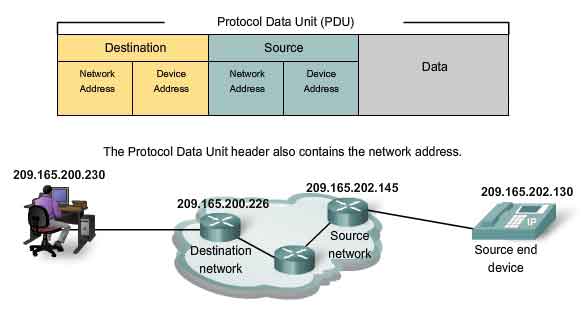
Getting the Data to the Right Application
At Layer 4, information contained in the PDU header does not identify a destination host or a destination network. What it does identify is the specific process or service running on the destination host device that will act on the data being delivered. Hosts, whether they are clients or servers on the Internet, can run multiple network applications simultaneously. People using PCs often have an e-mail client running at the same time as a web browser, an instant messaging program, some streaming media, and perhaps even a game. All these separately running programs are examples of individual processes. Viewing a web page invokes at least one network process. Clicking a hyperlink causes a web browser to communicate with a web server. At the same time, in the background, an e-mail client may be sending and receiving email, and a colleague or friend may be sending an instant message. Think about a computer that has only one network interface on it. All the data streams created by the applications that are running on the PC enter and leave through that one interface, yet instant messages do not popup in the middle of word processor document or e-mail showing up in a game. This is because the individual processes running on the source and destination hosts communicate with each other. Each application or service is represented at Layer 4 by a port number. A unique dialogue between devices is identified with a pair of Layer 4 source and destination port numbers that are representative of the two communicating applications. When the data is received at the host, the port number is examined to determine which application or process is the correct destination for the data.